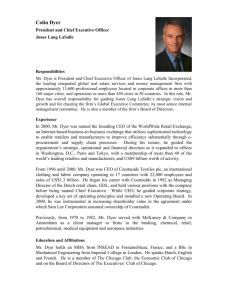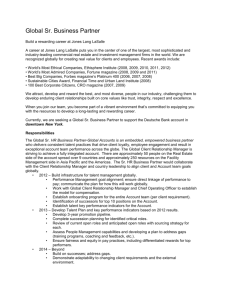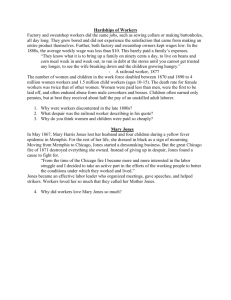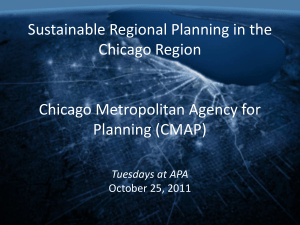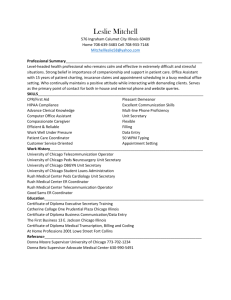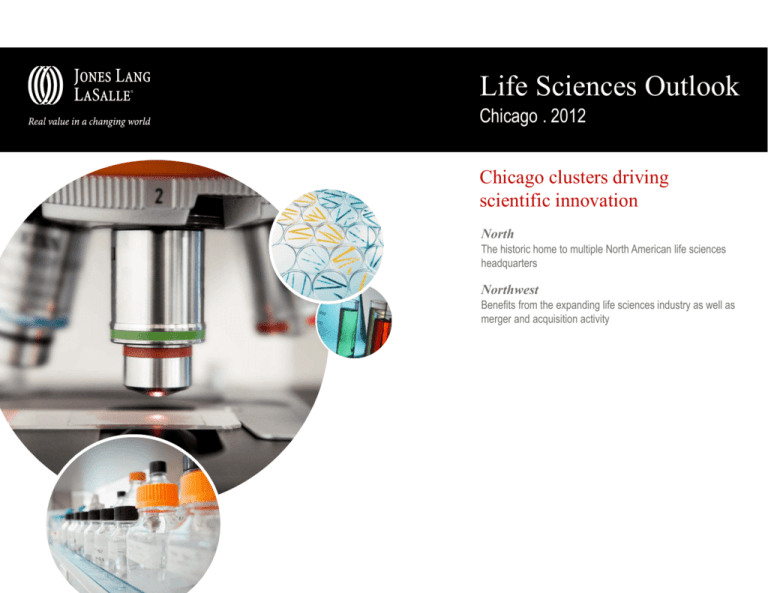
Life Sciences Outlook
Chicago . 2012
Chicago clusters driving
scientific innovation
North
The historic home to multiple North American life sciences
headquarters
Northwest
Benefits from the expanding life sciences industry as well as
merger and acquisition activity
Chicago
Jones Lang LaSalle • Chicago • 2012
The Chicago area has
developed a reputation as a hub
for research and innovation.
Global trends
The aftereffects of the recession, coupled with the European sovereign debt crisis, continue to
plague business operations in the mature market clusters of North America and Western Europe,
including those of life sciences companies of all sizes and maturity levels. Although most life
sciences companies continue to enjoy higher profit margins than those of other industry segments,
it has become markedly clear that the product development formula of the past no longer applies.
As a result, greater emphasis is being placed on the next wave of drugs and treatments – those
stemming from biological organisms. Additionally, companies are increasingly diversifying their
portfolios to mitigate risk and help fund the lofty costs of innovation, adding generic brands, crop
and animal science and even consumer products through mergers and acquisitions.
including Abbott Laboratories, Astellas, Baxter, Hospira, Takeda and Walgreens. These
companies, and many smaller life sciences firms, are located in the north suburban submarket.
The area benefits from large life sciences-related employment of nearly 45,000 individuals
employed in pharmaceutical, biotech and medical device disciplines.
The metropolitan area is home to several leading universities and institutions. These include
Northwestern University, the University of Chicago, the Illinois Institute of Technology (IIT) and
the University of Illinois at Chicago (UIC). The area also attracts graduates from other schools in the
state, such as the University of Illinois at Urbana-Champaign and Southern Illinois University
School of Medicine. The area’s universities are among the factors that identify Chicago as a life
sciences cluster.
Research is a heavy point of emphasis at area centers like the International Institute of
Nanotechnology at Northwestern, the Center for Pharmaceutical Biotechnology at the University of
Chicago and the Medical Imaging Research Center at IIT. The Illinois Medical District was created
in 1941. Since then the area has become rich with hospitals, medical centers and research facilities
including the biotech incubator, Chicago Technology Park. The 56-acre park features a 56,000square-foot research center for emerging ventures and roughly 118,000 square feet of graduate and
other facilities to accommodate more established companies.
Chicago life sciences scorecard
New product developments have become ever more costly and difficult to achieve. Drug makers
are attempting to achieve greater breakthroughs with less funds than in years past. The need to
increase a company’s likelihood of developing a new treatment continues to steer conversations
around location strategy. Although many companies maintain R&D in mature markets rich with
people capital and renowned research universities, others are turning to emerging global clusters
due to dedicated private and public funding.
Within the United States, life sciences-focused clusters are at various stages in their evolution. The
Northeast and California continue to dominate with their extensive university networks and deep
labor pools, but, more and more, emerging clusters offer great talent coupled with more competitive
real estate opportunities.
Chicago market overview
Since the opening in 1946 of Argonne National Laboratory, the first national science and
engineering research laboratory, the Chicago area has developed a reputation as a hub for
research and innovation. Headquartered in the Chicago area are large life sciences companies
11th
15th
$141.6
11th
$682.0
1.2%
18th
% life sciences
employment
0.7%
% life sciences
establishments
VC funding
(in millions)
Rank in relation to 21 United States clusters
Sources: Bureau of Labor Statistics, PricewaterhouseCoopers, National Institute of Health
NIH funding
(in millions)
Jones Lang LaSalle • Chicago • 2012
North / Northwest
Overview
A concentration of life sciences companies are found in the North suburban submarket. Until
recently, the long-standing presence of some of the largest pharmaceutical companies in the world
has attracted related companies specifically to this area. In the last several years, both Astellas
and Takeda Pharmaceuticals have made long-term commitments to the area by each building new
North American headquarters of 445,000 square feet and 630,000 square feet, respectively. More
recently, medical device maker Carefusion relocated to 150,000 square feet in Vernon Hills
Although life sciences activity had previously been limited the North suburban submarket, the July
2012 acquisition of Catalyst Rx by SXC Health Solutions to form Catamaran has expanded the
industry into the Northwest submarket. As a result of this merger, the two companies will
consolidate headquarters to occupy 250,000 square feet in Schaumburg with the potential to
expand by an additional 50,000 square feet during the first years of term.
In 2011 construction began on The Illinois Science + Technology Park in Skokie. The result of a
collaboration between Illinois Science and Technology Coalition, iBio and China’s Shanghai Bio
Pharmaceuticals Association, the 23-acre campus will provide laboratory, office and conference
space for life science-focused companies. Once fully complete, the site will offer a total of 2 million
square feet of advanced facilities.
Outlook
Activity in the coming months will be fueled by AbbVie, Abbott Laboratories’ most recent spin-off, as
well as the newly merged Catamaran venture. Although it is not yet known what AbbVie’s impact
will be on the market, if this spin-off goes down a similar path as Hospira, when it spun-off from
Abbott, it could require its own space.
Additionally, as corporations continue to take a hard look at their financial health, announcements
surrounding employment levels (and subsequent space needs) will be monitored closely. Many
global corporations, looking to streamline operations after a merger or in general, have been cutting
jobs in recent years. Takeda, for example, announced global layoffs earlier this year that would
impact operations in the United States. Other pharmas, meanwhile, are in expansion mode and
have been beating market expectations quarter after quarter. As M&A activity continues to heat up,
it will not be shocking to find widely varying space needs in the near- to mid-term.
Takeda campus at the intersection of I-294 and Lake Cook Road in Deerfield
CATAMARAN
In August of 2012 a newly
formed venture between
SXC Health Solutions and
Catalyst Rx signed a new
lease in Schaumburg for
250,000 s.f.
CAREFUSION
Medical device producer
Carefusion signed a new
lease in May 2012 in
Vernon Hills for 150,000
s.f.
ASTELLAS
In June 2012, Astellas
Pharma US completed
construction on its new
445,000 s.f. North
American headquarters in
Northbrook.
WALGREENS
Walgreens is in the market
for approximately 50,000
s.f. This comes on the
heels of signing a lease for
56,000 s.f. at 1000
Lakeside in Bannockburn
earlier in the year.
Activity key:
Leasing
Development
Sales
Tenants in the market
Headquartered
in the Chicago
area are large
life sciences
companies
including Abbott
Laboratories,
Astellas, Baxter,
Hospira and
Takeda, as well
as druggist
Walgreens.
Large blocks of space
About Jones Lang LaSalle
Jones Lang LaSalle (NYSE:JLL) is a financial and professional services firm specializing in real estate. The firm offers integrated services delivered by expert teams worldwide to clients seeking increased
value by owning, occupying or investing in real estate. With 2011 global revenue of $3.6 billion, Jones Lang LaSalle serves clients in 70 countries from more than 1,000 locations worldwide, including 200
corporate offices. The firm is an industry leader in property and corporate facility management services, with a portfolio of approximately 2.1 billion square feet worldwide. LaSalle Investment Management,
the company’s investment management business, is one of the world’s largest and most diverse in real estate with $47 billion of assets under management. For further information, please visit
www.joneslanglasalle.com.
Jones Lang LaSalle Research
Jones Lang LaSalle’s research team delivers intelligence, analysis, and insight through market-leading reports and services that illuminate today’s commercial real estate dynamics and identify tomorrow’s
challenges and opportunities. Our 300 professional researchers track and analyze economic and property trends and forecast future conditions in over 60 countries, producing unrivalled local and global
perspectives. Our research and expertise, fueled by real-time information and innovative thinking around the world, creates a competitive advantage for our clients and drives successful strategies and
optimal real estate decisions.
Jones Lang LaSalle
200 East Randolph Street
Chicago, Illinois
60601
www.us.joneslanglasalle.com
©2012 Jones Lang LaSalle IP, Inc. All rights reserved. No part of this publication may be reproduced by any means, whether graphically, electronically, mechanically or otherwise howsoever, including without limitation photocopying and recording on magnetic tape, or included in any
information store and/or retrieval system without prior written permission of Jones Lang LaSalle. The information contained in this document has been compiled from sources believed to be reliable. Jones Lang LaSalle or any of their affiliates accept no liability or responsibility for the
accuracy or completeness of the information contained herein and no reliance should be placed on the information contained in this document.



